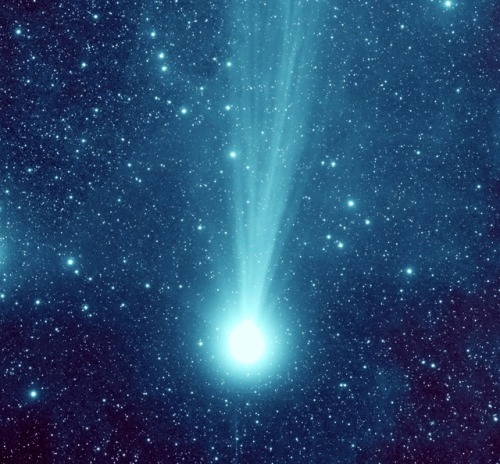The 2MASS Redshift Survey - The Single Most Comprehensive Survey Of The Universe… And Everything That’s


The 2MASS Redshift Survey - The single most comprehensive survey of the universe… and everything that’s in it.
More Posts from Riekod and Others






The Magellanic Clouds are two irregular dwarf galaxies visible in the Southern Celestial Hemisphere; they are members of the Local Group and are orbiting the Milky Way galaxy. Because they both show signs of a bar structure, they are often reclassified as Magellanic spiral galaxies. The two galaxies are:
Large Magellanic Cloud (LMC), approximately 160,000 light-years away.
Small Magellanic Cloud (SMC), approximately 200,000 light years away.
source
Image credit: Primoz Cigler, Joseph Brimacombe, Ed Dunens and EkantTakePhotos

my type of meme


Declining Arctic sea ice: The 2018 Arctic Report Card found the Arctic region had the second-lowest overall sea-ice coverage on record. The map shows the age of sea ice in the Arctic ice pack in March 1985 (left) and March 2018 (right). Ice that is less than a year old is darkest blue. Ice that has survived at least 4 full years is white. Maps were provided by NOAA Climate.gov and based on data provided by Mark Tschudi./University of Colorado/CCAR. (NOAA Climate.gov)
Excerpt from this Washington Post story:
Over the past three decades of global warming, the oldest and thickest ice in the Arctic has declined by a stunning 95 percent, according the National Oceanic and Atmospheric Administration’s annual Arctic Report Card.
The finding suggests that the sea at the top of the world has already morphed into a new and very different state, with major implications not only for creatures such as walruses and polar bears but, in the long term, perhaps for the pace of global warming itself.
The oldest ice can be thought of as a kind of glue that holds the Arctic together and, through its relative permanence, helps keep the Arctic cold even in long summers.
“The younger the ice, the thinner the ice, the easier it is to go away,” said Don Perovich, a scientist at Dartmouth who coordinated the sea ice section of the yearly report.
If the Arctic begins to experience entirely ice-free summers, scientists say, the planet will warm even more, as the dark ocean water absorbs large amounts of solar heating that used to be deflected by the cover of ice. The new findings were published as climate negotiators in Poland are trying to reach a global consensus on how to address climate change.
In March, NASA scientists with the Operation IceBridge mission, which surveys the polar regions using research aircraft, witnessed a dramatic instance of the ongoing changes. Flying over the seas north of Greenland, in a region that usually features some of the oldest, thickest ice in the Arctic, they instead saw smooth, thin strips binding together the thicker, ridged pieces.
420 more like 440 lol stay in tune, guys


Comet C/2014 Q2 Lovejoy
by Joseph Brimacombe
The Opportunity to Rove on Mars! 🔴
Today, we’re expressing gratitude for the opportunity to rove on Mars (#ThanksOppy) as we mark the completion of a successful mission that exceeded our expectations.
Our Opportunity Rover’s last communication with Earth was received on June 10, 2018, as a planet-wide dust storm blanketed the solar-powered rover’s location on the western rim of Perseverance Valley, eventually blocking out so much sunlight that the rover could no longer charge its batteries. Although the skies over Perseverance cleared, the rover did not respond to a final communication attempt on Feb. 12, 2019.
As the rover’s mission comes to an end, here are a few things to know about its opportunity to explore the Red Planet.
90 days turned into 15 years!
Opportunity launched on July 7, 2003 and landed on Mars on Jan. 24, 2004 for a planned mission of 90 Martian days, which is equivalent to 92.4 Earth days. While we did not expect the golf-cart-sized rover to survive through a Martian winter, Opportunity defied all odds as a 90-day mission turned into 15 years!

The Opportunity caught its own silhouette in this late-afternoon image taken in March 2014 by the rover’s rear hazard avoidance camera. This camera is mounted low on the rover and has a wide-angle lens.
Opportunity Set Out-Of-This-World Records
Opportunity’s achievements, including confirmation water once flowed on Mars. Opportunity was, by far, the longest-lasting lander on Mars. Besides endurance, the six-wheeled rover set a roaming record of 28 miles.

This chart illustrates comparisons among the distances driven by various wheeled vehicles on the surface of Earth’s moon and Mars. Opportunity holds the off-Earth roving distance record after accruing 28.06 miles (45.16 kilometers) of driving on Mars.
It’s Just Like Having a Geologist on Mars
Opportunity was created to be the mechanical equivalent of a geologist walking from place to place on the Red Planet. Its mast-mounted cameras are 5 feet high and provided 360-degree two-eyed, human-like views of the terrain. The robotic arm moved like a human arm with an elbow and wrist, and can place instruments directly up against rock and soil targets of interest. The mechanical “hand” of the arm holds a microscopic camera that served the same purpose as a geologist’s handheld magnifying lens.

There’s Lots to See on Mars
After an airbag-protected landing craft settled onto the Red Planet’s surface and opened, Opportunity rolled out to take panoramic images. These images gave scientists the information they need to select promising geological targets that tell part of the story of water in Mars’ past. Since landing in 2004, Opportunity has captured more than 200,000 images. Take a look in this photo gallery.

From its perch high on a ridge, the Opportunity rover recorded this image on March 31, 2016 of a Martian dust devil twisting through the valley below. The view looks back at the rover’s tracks leading up the north-facing slope of “Knudsen Ridge,” which forms part of the southern edge of “Marathon Valley
There Was Once Water on Mars?!
Among the mission’s scientific goals was to search for and characterize a wide range of rocks and soils for clues to past water activity on Mars. In its time on the Red Planet, Opportunity discovered small spheres of the mineral hematite, which typically forms in water. In addition to these spheres that a scientist nicknamed “blueberries,” the rover also found signs of liquid water flowing across the surface in the past: brightly colored veins of the mineral gypsum in rocks, for instance, which indicated water flowing through underground fractures.

The small spheres on the Martian surface in this close-up image are near Fram Crater, visited by the Opportunity rover in April 2004.
For more about Opportunity’s adventures and discoveries, see: https://go.nasa.gov/ThanksOppy.
Make sure to follow us on Tumblr for your regular dose of space: http://nasa.tumblr.com

Aurora Over Alaska (by HB Mertz)
As I get older I’m finding that a lot of the “intellectuals” I used to admire are actually just condescending and pretentious. And also realizing how much more important it is to be present, considerate, and empathetic because nobody really knows what they’re talking about and anyone who claims to know everything about anything is feeding you bs.

Drops that impact a very hot surface will surf on their own vapor, and ones that hit a very cold surface will freeze almost immediately. But what happens when the temperature differences aren’t so extreme? Scientists explored this (above) by dropping room-temperature water droplets onto a cool surface – one warmer than the freezing point but cooler than the dew point at which water condenses.
They found that impacting drops formed a triple halo of condensate (right). The first and brightest ring forms at the radius of the drop’s maximum extent during impact. The second band forms from water vapor that leaves the droplet at impact. As that vapor cools, it condenses into a second band. The final, dimmest band forms as the droplet stabilizes and cools. It’s the result of water vapor near the droplet continuing to cool and condense. (Image and research credit: Y. Zhao et al.; via Nature News; submitted by Kam-Yung Soh)
-
 mossywombat reblogged this · 4 years ago
mossywombat reblogged this · 4 years ago -
 dimens1ons liked this · 5 years ago
dimens1ons liked this · 5 years ago -
 saltythexfilesindianjonescop liked this · 5 years ago
saltythexfilesindianjonescop liked this · 5 years ago -
 alieenish liked this · 5 years ago
alieenish liked this · 5 years ago -
 mossy-scaled-dragon reblogged this · 5 years ago
mossy-scaled-dragon reblogged this · 5 years ago -
 mossy-scaled-dragon liked this · 5 years ago
mossy-scaled-dragon liked this · 5 years ago -
 fearless2600 liked this · 5 years ago
fearless2600 liked this · 5 years ago -
 cptnbg liked this · 5 years ago
cptnbg liked this · 5 years ago -
 thefuckword-deactivated1637 liked this · 5 years ago
thefuckword-deactivated1637 liked this · 5 years ago -
 deathbytori liked this · 5 years ago
deathbytori liked this · 5 years ago -
 melodic-aurora liked this · 5 years ago
melodic-aurora liked this · 5 years ago -
 16fahri liked this · 5 years ago
16fahri liked this · 5 years ago -
 drucius liked this · 5 years ago
drucius liked this · 5 years ago -
 notisaidthechicken liked this · 5 years ago
notisaidthechicken liked this · 5 years ago -
 insidiousclouds-2 liked this · 5 years ago
insidiousclouds-2 liked this · 5 years ago -
 fagdykefrank liked this · 5 years ago
fagdykefrank liked this · 5 years ago -
 therealsirsticker liked this · 5 years ago
therealsirsticker liked this · 5 years ago -
 christinakroft liked this · 5 years ago
christinakroft liked this · 5 years ago -
 covenawhite66 reblogged this · 5 years ago
covenawhite66 reblogged this · 5 years ago -
 covenawhite66 liked this · 5 years ago
covenawhite66 liked this · 5 years ago -
 blue---oak liked this · 5 years ago
blue---oak liked this · 5 years ago -
 bermudatriangleboy reblogged this · 6 years ago
bermudatriangleboy reblogged this · 6 years ago -
 bermudatriangleboy liked this · 6 years ago
bermudatriangleboy liked this · 6 years ago -
 technes liked this · 6 years ago
technes liked this · 6 years ago -
 samtjahajoe liked this · 6 years ago
samtjahajoe liked this · 6 years ago -
 hermd123-blog liked this · 6 years ago
hermd123-blog liked this · 6 years ago -
 ingriisdeux reblogged this · 6 years ago
ingriisdeux reblogged this · 6 years ago -
 ingriisdeux liked this · 6 years ago
ingriisdeux liked this · 6 years ago -
 xironprincessx liked this · 6 years ago
xironprincessx liked this · 6 years ago -
 mexican-katycat liked this · 6 years ago
mexican-katycat liked this · 6 years ago -
 wildirishboytoo reblogged this · 6 years ago
wildirishboytoo reblogged this · 6 years ago -
 gayssss-blog liked this · 6 years ago
gayssss-blog liked this · 6 years ago -
 glacialdrip reblogged this · 6 years ago
glacialdrip reblogged this · 6 years ago -
 glacialdrip liked this · 6 years ago
glacialdrip liked this · 6 years ago -
 spaceepigeon liked this · 6 years ago
spaceepigeon liked this · 6 years ago -
 local-cutie-xd liked this · 6 years ago
local-cutie-xd liked this · 6 years ago -
 quintiton liked this · 6 years ago
quintiton liked this · 6 years ago -
 pepperownme liked this · 6 years ago
pepperownme liked this · 6 years ago -
 unknownstuntman-blog1 liked this · 6 years ago
unknownstuntman-blog1 liked this · 6 years ago -
 deannovo liked this · 6 years ago
deannovo liked this · 6 years ago -
 phantasmachine reblogged this · 6 years ago
phantasmachine reblogged this · 6 years ago -
 adventuresofitzel liked this · 6 years ago
adventuresofitzel liked this · 6 years ago